Mental handicap
In 1905 Little Mollands, once part of the South Ockendon Hall estate, was bought by West Ham County Borough Council for use as a farm colony to provide three months' relief work for men not entitled to unemployment benefit. (The men each received 10s (50p) per week, although the cost of maintaining a 'colonist' was estimated to be 30s (£1.50) per week.) During WW1 the farm housed German prisoners-of-war.
In the 1930s, because of the difficulty obtaining accommodation for the mentally handicapped, the West Ham County Borough Council built a facility on the Little Mollands site for such patients. At this time South Ockendon was a village in a predominantly rural area and remote from the London Boroughs from where most of the patients came.
The South Ockendon Colony opened in 1932, consisting of two and one-storey villas separated by grass, trees and paths. The villas were all named after trees - Beech, Laurels, Pines, Willows, Limes, etc. The buildings with their extensive grounds occupied 84 acres, with an additional 98 acres of farmland. Originally intended to have 750 beds, only nine wards (with 520 beds) had been completed by the outbreak of WW2, along with the administration offices, recreation buildings, staff accommodation, workshops, the central kitchen and laundry.
By 1945 the Hospital was seriously understaffed, many nurses having enlisted. Student nurses would find themselves in complete charge of 50-60 patients. One of the problems was that hospitals for the mentally handicapped were rarely attractive to nursing staff, as the patients showed limited improvement, even after years of diligent effort by carers, and recovery was improbable.
The Colony joined the NHS in 1948, when it was renamed the South Ockendon Hospital. It became the main part of the South Ockendon Institution for Mental Defectives, which included Bramley House, Great West Hatch, Little West Hatch, Leytonstone House, Duvals, New Lodge in Billericay and an annexe at Ramsey Lodge in Harwich. The Institution had 1056 beds.
In 1955 the Duchess of Gloucester became the first member of the Royal family to visit a hospital for the mentally handicapped, when she laid the foundation stone for the new clinical centre - the Gloucester Clinic - and formally opened two new villas 'Hazels' and 'Hawthorns', already filled with patients.
Throughout this period the Hospital was chronically overcrowded and understaffed. Several factors had contributed to this. With vaccinations and better treatments for common infections, the numbers of severely mentally handicapped children surviving into adulthood had greatly increased, and many more severely handicapped adults were living into old age. Thus, the effects of overcrowding and understaffing were exacerbated as the proportion of heavily dependent patients increased. In 1959 the responsibility for providing residential care for patients not requiring hospital treatment had returned to the local authorities (the cost of such care was to come from the rates), but provision of hostel accommodation was slow, and hospitals continued to have to accept patients on social grounds, regardless of whether or not they needed treatment. In 1960 the catchment area for the Hospital was extended. The lack of hostels meant that an increased numbers of patients had to remain in the Hospital, despite protests from the Hospital Management Committee. Staff levels continued to be inadequate.
Cypress Villa opened in 1967 as a Regional Secure Unit for mentally handicapped psychopaths. It ceased to be a secure ward in 1969 as a result of complaints of inhumane treatment by the mother of one patient. The complaints were upheld and the patient was transferred to Cell Barnes Hospital in January 1970. Cypress Villa became a ward for disturbed patients.
In 1967 reports began to appear in national newspapers about the scandalous conditions in hospitals for the mentally handicapped, particularly the Ely Hospital in Cardiff.
In 1968 South Ockendon Hospital had 1065 beds and, although nearly £1m had been spent on new buildings and extensions, it was still overcrowded, with the new wards built for 30 patients containing 55 on average. In particular, Beech Villa was overcrowded and understaffed, and violent attacks by patients on other patients and staff were happening frequently. In February 1969 a patient died from severe internal injuries and a summons alleging manslaughter was served on a fellow patient. A jury was empanelled to determine whether the patient was fit to plead to the indictment; it was decided he was not, and he was returned to South Ockendon Hospital. In March the Hospital Management Committee banned all admissions, this drastic action being approved by the Secretary of State. But, by March of the following year, the number of patients had been reduced by a mere 35. In July 1970 the Hospital agreed to admit one new patient for every four discharged.
In the early days of the NHS, able-bodied
patients
had worked in the wards, kitchens, laundry, gardens and farm or in
workshops but, by the 1970s, only the Upholstery Department remained.
The patients had little occupation. The Occupational
Therapy provided
some diversion - painting, music, movement, drama, needlework,
woodwork, domestic science and cooking, but space was limited (only 113
patients could attend) and activities had to be tailored to the
patients'
abilities. An Industrial Therapy unit provided places for 51
patients
engaged in light assembly and packaging work. The Activities
Centre
enabled a further 114 more severely mentally handicapped patients to
play games, do painting and drawing, make music or play with toys.
Patients left on the wards had little to do, but various clubs
were
organised for team games, dancing, swimming and trampolining.
Elderly
semi-ambulant and non-ambulant patients played table games, such as
dominoes and cards, or listened to records, while a voluntary youth
club, run by a committee formed from the local youth clubs, organised
disco dances, bingo, table tennis, snooker, table games, painting and
knitting for the younger patients.
In 1971 a school was opened on the site for educationally subnormal children under 16 years of age. Although by now the patient number had been reduced to 955 (most discharges being transferred to the newly created Little High Wood Hospital), the Hospital was still understaffed, with a higher proportion of severely mentally handicapped patients than other similar hospitals.
In February 1972 newspaper reports appeared about a police investigation into the death of an elderly male patient. This followed an incident in Willows Ward, which housed 48 subnormal and severely subnormal males. In April the Secretary of State set up an inquiry into the care of patients at the Hospital. The Coroner's jury had returned a verdict of accidental death after two male nurses testified that the patient had been struck in the back by another patient, had slammed into an open door and then fallen onto a wheelchair, but the Committee of Inquiry found the patient's injuries incompatible with this explanation.
The Report of the Committee of Inquiry into South Ockendon Hospital was published in 1974. It led to a nationwide reappraisal of mental care in the United Kingdom. In the same year, Gloucester Drive - a terrace of six single-storey houses - opened in the South Ockendon Hospital. Each house provided accommodation for three high-grade patients, who would receive training to prepare them to live in the outside world - learning how to handle money, shop, cook and clean.
By 1976 the Hospital had 820 beds and, in 1979, 724. Gradually patients were sent to live in smaller units of care, sheltered hostel accommodation or returned to their families.
In 1990 it had 594 beds.
The Hospital finally closed in 1994.
Present status (April 2009)
The site has been redeveloped. It is now Brandon Groves Estate, which was completed in 2000 and contains 688 dwellings. The streets are named after trees, just as the ward blocks of the Hospital were.
The central part of the site contains mature trees, which would have been inherited from the Hospital era. Little else remains. A building that looks as though it could have been a chapel is used as a local community club.
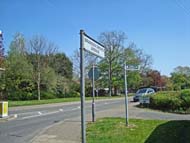
The mouth of Brandon Groves Avenue, off South Road.
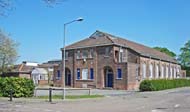
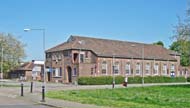
The Community Club and Hall, both older buildings with a number of bricked up windows, are located near the centre of the site and are arguably inherited from the Hospital.
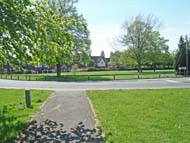
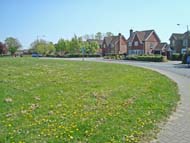

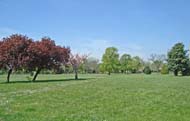
Inside the new estate, new housing surrounds grassland containing mature trees.


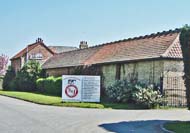
The entrance to Little Mollands Farm, which is no longer a working farm but a small industrial estate. It is unclear which buildings survive from the Hospital era.
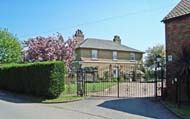
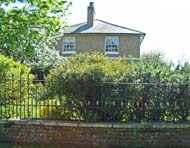
A large house on the east side of the Mollands Farm area could be of the right period, but looks heavily restored, if so. Little Mollands was originally an Elizabethan house, but a Georgian building was built around it, doubling it in size (personal communication: Vivien Cooper).
Inskip JH 1974 Report of the Committee of Inquiry into South Ockendon Hospital. London, HMSO.
http://en.wikipedia.org
http://hansard.millbanksystems.com (May 1922)
http://hansard.millbanksystems.com (July 1922)
http://hansard.millbanksystems.com (1945)
http://hansard.millbanksystems.com (1969)
http://rcnarchive.rcn.org.uk
http://seax.essexcc.gov.uk
www.archive2.official-documents.co.uk
www.bbc.co.uk
www.british-history.ac.uk
www.flickr.com
www.mencap.org.uk
www.sochealth.co.uk
www.studymore.org.uk
www.thurrock.gov.uk
www.timesonline.co.uk
www.unlockingthepast.org.uk
Return to home page